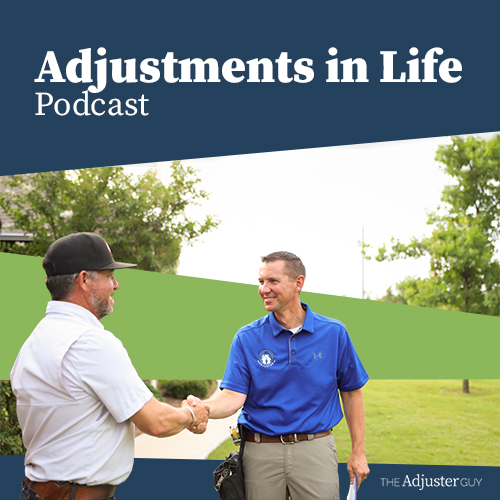Links
Hipplock website: https://hipplock.com/
Vince Gains on LinkedIn: https://www.linkedin.com/in/rick-roberson-4380a817https://www.linkedin.com/in/vince-gaines-aa839874
Transcript
Alan: Welcome back folks to another episode of The Adjustments in Life. It’s a pretty exciting episode I have in store for all of you listeners today.
I have a co-host with me as well, Mr. Jason Dyson is here to co-host on the program today, and we have a very exciting guest. This guest is the actual inventor and developer of the tool most of you adjusters are going to know about it—and if you don’t already, you’re going to find out about it—called the Hipplock.
So I want to welcome our guest Mr. Vince Gains with Hipplock. Welcome to the show Vince!
Vince: Thank you very much. I appreciate it. I enjoy being here.
Alan: You bet! This is pretty exciting. I always like to have people on the show that can share with us their stories. And you’ve got a pretty neat product out on the market right now—that I personally have not had the opportunity to use, but I’ve been able to see it and really, really excited to use it. Jason’s been gracious enough to let me use his to try it out.
Give us a little bit of your story. Where did this thing come from?
Vince: Well, I’ve been an adjuster for years and years—residential, commercial, a little bit of everything. I live a little bit north of Atlanta, Georgia; well, if you’ve ever been to Atlanta and you’ve seen the roofs that are here, everything here is a 10/12 and a 12/12 and three stories high. It’s not a joke.
I’ve seen roofers step on a shingle and it slide out from under them and end up on the ground or hanging off a gutter. It’s just no joke.
And that was okay when I was younger. When we’re all younger and you’re running around that roof up there like it’s no big deal, and the older I got the less I did that. And I began to realize, if I was going to stay in this industry, I was going to need something that was going to keep me alive and keep me safe so that I could keep earning the money that I could get and support my family.
So I got to looking around and nothing out there did what I wanted it to do. So I started just finding ways to build something for me. And that’s where it started—it was for me, it was a selfish thing.
I went and bought a tube bender, I had a shed in the backyard with a 12/12 pitch on it, and I just started bending steel tubes to try to get the design and the shape and the functions that I wanted out of it just to do a gable roof.
It took me about a year—between deployments and working on roofs and trying to come home at night and do that. I finally got the design that I wanted. Well a steel tube is not exactly the best material to be lugging up a roof, so I had to find something lighter.
So that was not any fun—I tried that too and it was not any fun. So I got an engineer involved, hired an engineer and we put together the product you see now. Originally it was just a base package.
The big thing for me and developing this thing to begin with is I wanted to get on the hip of the roof. Nothing out there allowed you to do that. Once I got the base package set up and I could get on a gable roof, I started working on the hip section.
And it took about another year, but I finally got that developed—and that was heavily involved with an engineer and just looking at the dynamics of that and what needed to happen to make that a safe transition.
So it’s taken a little while to get the product where it is now, but I’m really happy with what it is. As I developed this and people saw it, they just kept encouraging me to put it on the market and sell it. But that’s just not my background, my background is in construction.
But it’s turned out really well. My whole goal was to make something safe that would benefit the industry. And I think it’s done that, and I’m happy with it where it is right now.
Alan: Yeah, I can see where—I’m pretty impressed with it. Again, I have not had the chance to use it yet.
But I’m curious because I can see where it’s very stable to use on that gable roof, but I have a little bit—you know I’m sitting here thinking ‘how is that going to feel when I get on that hip roof. Can you kind of give us how that stabilizes itself or can you go one direction or another?
Jason: Alan, I do want to point out here, the one we have on display here in front of us—my particular one—I do not have the hip access piece attached to it.
Alan: Okay, okay. So Vince is there—okay so that outrigger then rests on the rig?
Vince: That’s called an outrigger…that’s kind of where I started—that’s how it got its name as the outrigger, because it came out in opposition and was supposed to sit on the ridge cap and stabilize it so you could pull it sideways. Well that didn’t work out. The dynamics of that—it just twisted off the roof and the outrigger just never came into play.
So I had to back up and look at it through a different option of a way of doing that and; that’s when I got an engineer involved.
If you look on the website, you’ll see the differences between the base package and the plus package. The plus package has got a red frame similar to the blue frame you’re seeing in front of you, and that red frame is smaller and sits inside the blue frame.
There’s opposing foot pegs on that frame. So what you do when you get it on the roof is you take the red frame and you rotate it so that those opposing pegs come in contact with the roof.
There’s an adjustment bolt that you adjust by hand and it does not have to be severely torqued. What you’re looking for is to get pressure on those feet. Now once you’ve got pressure on those feet, that is what allows you to pull it to the right and to the left to get on the hip—it’s a pressure fitting is all it is.
It prevents the device from rotating off the roof and sliding around. It also helps on a metal roof, because on a metal roof, the device won’t sit flat on the roof because the ribs—the seams. So that outrigger helps you secure it so it’s not—it doesn’t slide around, it’s not so squirrelly.
Alan: Gotcha! So this product actually is built for not just an asphalt roof, it is capable of handling metal as well.
Vince: I’ve had it on metal, wood, slate—I’ve actually had this on a 17/12 slat roof on a church.
Alan: Wow!
Vince: Now, obviously, I’m not going to advertise that you can use it on a 17/12 roof for liable reasons, so please understand that.
Get comfortable with it and find out what it can do first!
Alan: Absolutely. So, in the perspective of safety certified equipment, is the Hipplock a safety certified piece of equipment?
Vince: I get this question a lot, and I did contact OSHA for that very reason. And what OSHA explained to me is they do not certify anything—they only enforce the rules; but they don’t certify it.
And again, if you’ll look at my website, the one thing I did is I had a 10 foot rot section run off my shed—that 12/12 roof. So what OSHA said is you’re supposed to drop so much weight 10 feet and it’s supposed to handle that shock wave. So what I did is I put 250 pounds on a buggy—for lack of a better definition—on wheels. And I dropped it 10 feet, and the device was not bolted in, it was simply sitting on the roof, It withstood the shock, it stayed on the roof, it performed beautifully.
It worked the frame. That device can’t ever be used again, but think about that. You’re on a 12/12 pitch roof—if you fall 10 feet well you did it wrong, because 9 times out of 10, if you’ve ever been on a roof, you’ve got that rope tight or semi tight at least.
So in realistics, you’re going to fall a foot or two—I’ve already demonstrated that at 250 pounds, if you fall 10 feet straight down, nonstop, on wheels, gaining as much momentum as you can gain, it will keep you on the roof. The device will hold.
Alan: I didn’t know that. I haven’t really looked into OSHA rules or OSHA specifications, but even if you did fall that 10 feet, if the tools are no longer usable at least you made it through the fall. The tool may not have had it, but at least you made it through the fall.
Jason: You’re still usable! Guys I can attest to that. Thankfully, I’ve slimmed down a little bit, but when I first purchased my Hipplock, I was right at 300 pounds. The first roof I got on with it was a 12/12 pitch—I was doing a hail inspection—never really rope and harnessed anything.
Eighteen years in the industry and finally got talked into by my wife to actually find something to be a little safer to do this.
But I set it up—it took me a long time, you know, I played with it setting it up—but basically getting in my harness and making sure everything was right. That first step off the ladder, getting on a slope face and not a valley with the ascender in one hand and slack in the other—it didn’t bow, it didn’t move, it didn’t slip. There was nothing—basically I leaned back in my harness and that thing was just rock steady. It seemed like—at least the engineering of this design—really the more pressure you put on that rope, the harder—it was just real stable.
I was impressed with the fact that I was able to set it in one place and be able to go up the slope and pivot what I needed to to do a proper inspection and proper test square without having to move the head of it. I was able to pivot on my rope.
Vince: That was the whole purpose of—that’s really why I designed what I did. Because there was nothing in the industry that allows you to do just that. Not only that, but if you’re doing a hail inspection, wind inspection or whatever it is, you gotta do both sides of the roof.
This one, you hook into the device with a carabiner and the rope is on the carabiner; so I tie one knot and I never untie it. I clink in with the carabiner. Now when I need to go to the backside of the roof, instead of picking the device up and spinning it,all I’ve gotta do is get the carabiner off the front and put it on the back.
It’s there; it’s ready to be used.
Alan: Which is huge, because if you’re using a standard rope and harness, you’re literally you’re down off the roof resetting your gear so that you can move around to the other side and approach the roof again.
Vince: Right. And this one makes that very quick and easy which is the whole point. I mean, as adjusters, you’re on a time schedule. You spend hours messing with the rope, throwing it over the roof, tying off to everything in the world; it still doesn’t give you a very viable option to do the hip that way. Whereas, you’re going to spend five, six minutes putting this on the roof, do your inspection, get off the roof and go to the next one.
Jason: Absolutely. I’ve also found that on roofs—maybe they’re old and degranulated or something that I can actually climb and I don’t necessarily need it for using my ascender to climb the roof—but for a extra hand, I throw the thing—because it is so light—over my shoulder and climb the valley, set it on the ridge, then i can pivot out and do my test square as well—instead of using the poles to run it up for whatever particular situation I’m in.
Alan: What is the approximate weight of this—of the unit itself?
Vince: Twelve pounds—and that’s the full device. That’s the plus package device. There is a development—I’m working on something now to make it lighter using a different material. It’s gonna be a bit complicated, so I’m not sure how long it will take to get that developed. It’s also got some accessories that will go with the device—more along the lines for roofers than for adjusters—but I’ve got some other things that are in development for the device.
Alan: Great. Did you have a question [Jason]?
Jason: No, I’m just learning and excited to see what the next steps are for the product. I know I’ve enjoyed mine. And again, I just couldn’t get over how stable it felt when I was in it—especially that first time, that very first step onto a roof when you’re putting your trust into a product and after that first step it was ‘oh, this is easy. You know, lean back and let the equipment do the work.’ You know, buy a nice rope, buy a nice ascender and belay, and it will hold.
Vince: And I will go over—I mean this is not without a fault—so I will go over a couple of the issues that people do need to be aware of with the device. You were talking about using it on a roof that’s got the loose granules and it’s tough to keep your footing.
That’s great on a gable, but if you’ve got a roof that’s got the loose granules on it and you’re having trouble keeping your feet under you, DO NOT use the outrigger and put yourself on a hip. Because it’s a pressure fitting, and if the granules are loose, all that pressure’s going to do is cause those granules to come out from underneath you and the device will come loose.
When you’re on a roof like that, I do not recommend using the outrigger and getting on the hip on a roof in that condition. Now if the roof is in normal condition, you can walk on it, then it’s fine.
Be very careful with a roof that’s in that type of a condition—getting on the hip with the outrigger.
Alan: That’s good to know. Is there anything else that over time time has proven to maybe pay attention to when using it outside of that?
Vince: The only other issue that has come up—and I noticed this when I was developing it—you got some of these roofs that got like a 4 or a 5/12 pitch back slope and the front slope is a 12/12. None of us like those.
This device will not work on that, because you are eliminating the opposition resistance. When you get on it, there’s no opposition resistance because its sitting flat on that roof on the backslope. It’s got nothing to pull against.
So that’s really the only roof that I’ve found that you can not use it on—is when you have it set up like that.
Alan: I can see where that would be difficult for it to get ahold of. Obviously that’s not—well, it might be getting more common now to see that than it was 10 years ago.
Jason: I think it’s a regional thing—you know, where you’re at in the country as far as construction methods.
Alan: Yeah, but I can definitely see how that would be a difficult way for it to get ahold of considering the angles that it attaches to.
What’s in the future for Hipplock? What direction are we going? Obviously, you’re constantly in development stages to better the product. What’s the direction for growth?
Vince: I’ve been really surprised to see the different industries that have gotten involved with Hipplock. Things I didn’t think about that people have seen about the device and called and asked questions.
Obviously roofers and adjusters and engineers, but it’s been gutter cleaning industries, pressure washing and cleaning industries for the roof, Christmas lights, solar panel installation—it’s been a number of different industries that I’ve been shocked to see come in.
Right now, the primary thing that I’ve been working on—it’s a pretty reasonably light product. I would like to see it get lighter, and I have a direction that I’m moving towards with that. It is going to take quite a bit of engineering and outside forces to make that happen.
So it may take some time, but I am moving forward with getting it lighter and easier to deal with. Right now it’s aluminum with a powdered coat paint on it; well that gets chipped up and it looks bad. It’s a tool, so that’s okay but I would like to see it get to a position where the chips are not shown as much with the product being much lighter and easier to deal with.
I’m going to leave it at that because I don’t want to give away too much, but once I’ve got that developed and got that figured out—and I’ve got a plan for it and good idea at how that’s going to happen, but again I’ve gotta get the engineers and all involved in that and get that designed and manufactured and testing and things like that.
Alan: Can you tell us what the website is that you can get this product at?
Vince: Yes, it’s Hipplock.com. And Hipplock is spelt wi to ‘P’s so that’s h-i-p-p-l-o-c-k dot com. On that website, there are several videos right at the top, so you can see those testing videos that we’ve talked about today. I did a test on the gable, I did a test on the hip, and then there’s some videos that kinda go over how to use it and set it up.
Alan: Do you—and I know people are going to ask this, but I get emails now and then after we have a show you know asking questions about some of the things that we discuss. Does your website have options to buy rope and harness tools to go with it as a package or is it just the tool itself?
Vince: Right now, it’s just the tool itself. I do plan in the future to have ropes, carabiners, ascenders—I will never carry a harness EVER. The harness has got to be your decision, just because there’s so much liability involved with that.
Technically, you’re supposed to have a full body harness. The problem with a full body harness is that the connection to the rope is in the middle of your back. Well, if you fall on the roof, it’s going to twist and snap you around and it’s probably going to do a little more damage to you than if you used it on the front.
But I have not found a full body harness that allows you to connect in the front the way we need it. We are on the roof’s angle and working face down to the roof where the rope needs to be, so I have always used a waist harness.
But for that reason, I probably will never carry a harness—you’ll have to buy that somewhere else—but I do plan to have in the near future the rope, ascender, and carabiners. I’m in negotiations with people right now for that.
Alan: Good deal. I know as a consumer myself, if I can do kinda a one-stop shop and get everything i need from where I buy the products i want that sure does help.
Anything else you want to talk about with him Jason?
Jason: I mean, I’ve had mine a short period of time, I’ve used it a number of times—very comfortable with it—I’ve shown it to numerous people from different industries—again roofing and adjusters, I also showed it to a firefighter who is pretty interested in it. It’s a really neat product and I just enjoy that we can support somebody in our industry—a small company. When I ordered mine, the customer service was just outstanding for any company that you can deal with.
Vince: Well, I appreciate that.
Alan: That’s good stuff. Well, hey Vince, man I really appreciate you coming on today. I’m really happy that we can utilize this program to help support Hipplock with you and get the information out to the adjusters and those in the industry that are looking to buy these tools.
Obviously, every adjuster is looking for that opportunity to be able to invoice more for the opportunity and as well as be safe on the roof. I think you’ve developed a wonderful product here that serves both of those purposes very well.
So again, I just thank you for coming on the show.
Vince: I really appreciate you having me. I’ve really enjoyed the discussion.
Alan: Well, as things develop, let’s get back together again and talk about some of the updates and new products that come about as Hipplock grows.
Vince: I’d appreciate that. I’d enjoy that.
Alan: Well okay, alright folks. Vince Gains with the Hipplock. If you’re looking for a safe way to approach your roof, get your inspections done, you need to look up Hipplock.com or give Vince a call and discuss what he has to offer for you and get that situated.
So Jason, any last words?
Jason: Always a pleasure. Go out, watch his videos, take a look at the product—don’t just take my word for it. I have spoken to a single person—my buddies that have it—that’s how I found it was through friends of mine. I haven’t seen anybody say anything but good things about it.
Take a look at the videos on his website and decide for yourself.
Alan: Alright, folks, thanks for joining in. We’ll see you in a couple weeks.





